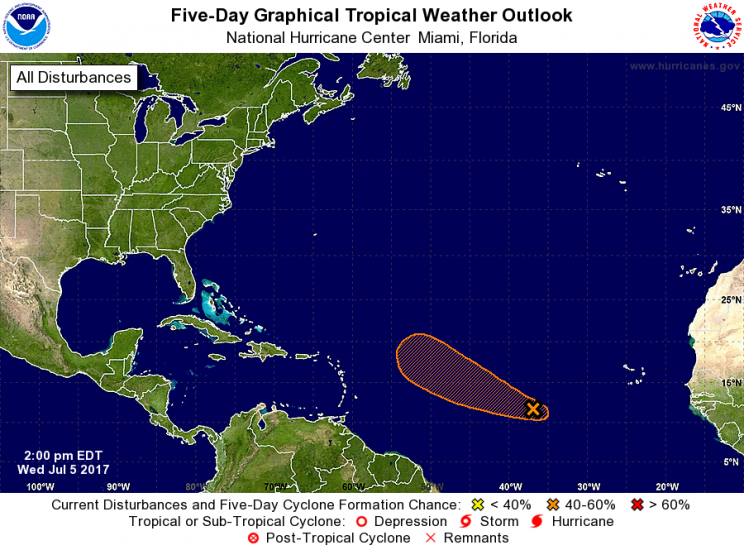Tropical Storm Don less likely to form this week, experts say

The metaphors wrote themselves when it looked like “Tropical Storm Don” could hit the East Coast, but it may not materialize after all. (And the name is a coincidence, not a jab at President Trump.)
Atmospheric scientists have their eyes on rain and thunderstorms in the Atlantic that could escalate into a tropical cyclone in the coming days, and they say it’s unlikely a full-on tropical storm at this point.
The National Oceanic and Atmospheric Administration’s (NOAA) National Hurricane Center on Wednesday downgraded the likelihood that the low-pressure system will become either a tropical storm or tropical depression from 70 percent to 60 percent.
“There is no Tropical Storm Don, nor a tropical depression, at this time,” Dennis Feltgen, a NOAA public affairs officer and meteorologist, told Yahoo News.
NOAA climatologists say the low-pressure system that they are tracking over the tropical Atlantic Ocean roughly 850 miles west-southwest of the Cabo Verde Islands could become a tropical depression before moving into drier and more stable air during the next day or two.
Mike Brennan, a senior hurricane specialist at the NOAA’s National Hurricane Center in Miami, explained that a tropical depression is a type of cyclone with sustained winds of less than 39 miles per hour. If these winds don’t pick up, it wouldn’t even get a name.

“A system gets a name when it becomes a tropical storm. Depressions don’t get names. They just get numbers,” Brennan said to Yahoo News. “When a system reaches tropical storm strength, it gets a name.”
Tropical storms, by comparison, have sustained winds of between 39 and 73 miles per hour. Hurricanes have sustained winds of 74 miles per hour or greater.
“We still think it has the chance of becoming depression in a day or so before it moves into an environment that’s less favorable for development or strengthening, as it gets later into the week and into the central tropical Atlantic,” Brennan said.
Brennan said the model guidance suggests this system won’t affect any land areas and that it would be pretty short-lived and likely dissipate over the tropical Atlantic — even if it becomes a tropical cyclone. But, he said, these systems are good reminders that we are in hurricane season and that it will become busier later in the summer.
“It’s a good time to remind everyone in the United States who lives in a hurricane-prone area to know what their risk is and to have a plan. One of the most important things people can know is if they live in an evacuation zone for a storm surge and know what they would do if told to evacuate.”
The World Meteorological Organization decides upon the names for tropical storms and hurricanes in the Atlantic Basin. There are six lists of names (alternating between female and male) that the scientists rotate through each year. The 2017 list was last used in 2011.
If a storm is particularly deadly or costly — such as Katrina or Sandy — the organization committee can decide to remove the name from the list out of respect at an annual meeting. They then choose a different name to serve as its replacement.
“Sometimes we have systems that already have strong enough winds so that when they do get a well-defined center or enough shower and thunder activity around it that they go straight to being a storm, and skip the depression stage,” Brennan said.
The National Hurricane Center is continuing to watch the low-pressure system as it develops. But a Tropical Storm Don may still form this year — the next tropical storm will assume the name regardless of what happens to this particular weather pattern.
“The next tropical cyclone that has maximum sustained winds of 39 mph or higher will be given the name ‘Don’ as the fourth named storm of the 2017 Atlantic hurricane season,” Feltgen of the NOAA said.
Read more from Yahoo News:



